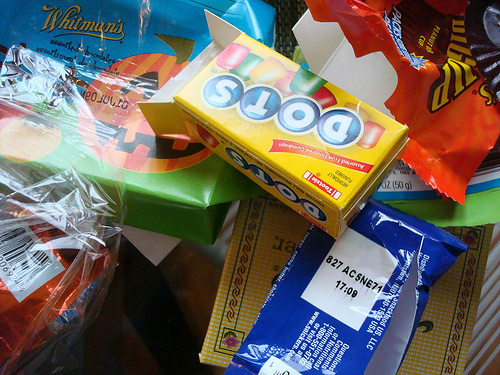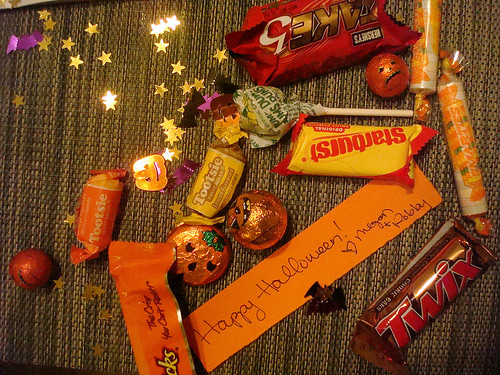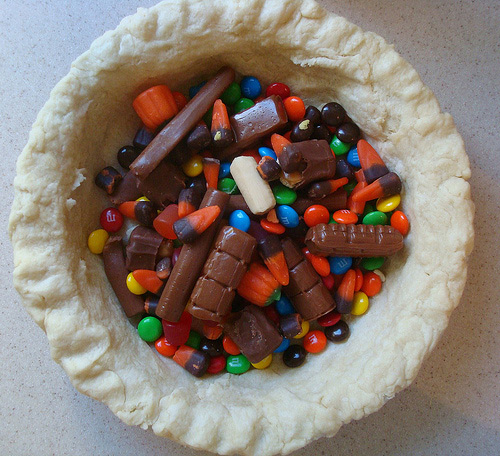 Trick or treating. The very phrase evokes a shiver of sweet, sugary anticipation, because basically, it usually culminates in the consumption of candy.
Trick or treating. The very phrase evokes a shiver of sweet, sugary anticipation, because basically, it usually culminates in the consumption of candy.
 But where on earth did this sweet tradition come from? Let's learn a bit about the history of Halloween and how it ultimately equaled candy corn overdose, shall we?
But where on earth did this sweet tradition come from? Let's learn a bit about the history of Halloween and how it ultimately equaled candy corn overdose, shall we?
First: What is Halloween? Per the Encyclopedia,
The word comes from medieval England's All Hallows' eve (Old Eng. hallow = "saint" ). However, many of these customs predate Christianity, going back to Celtic practices associated with Nov. 1, which was Samhain , the beginning of winter and the Celtic new year. Witches and other evil spirits were believed to roam the earth on this evening, playing tricks on human beings to mark the season of diminishing sunlight. Bonfires were lit, offerings were made of dainty foods and sweets, and people would disguise themselves as one of the roaming spirits, to avoid demonic persecution.
Per this site, it is the Celts who are credited with bringing Halloween stateside:
Halloween was brought to America in the 1840's by Irish immigrant fleeing their country's potato famine. New England added pranks like tipping over outhouses and unhinging gates to the practive of dressing up.
 But what of Trick or Treating itself? From the same source cited above,
But what of Trick or Treating itself? From the same source cited above,
"Trick-or-treating" came from a 9th century European custom called "souling." On November 2, All Souls Day, Christians would walk from village to village begging for "soul cakes" made from bread and currants. People would offer paryers for the deceased believing it would speed up a soul's passage to heaven. The more cakes given out, the more prayers offered.
Of course, it wasn't really til the 20th century that Trick or Treating really began in earnest. Now, I'm just spitballing here, but it seems rather timely that this coincides with a large increase with commercial production of candy. Per an article I discovered on What's Cooking America,
"Sometime in the middle of the 1930s, enterprising householders, fed up with soaped windows and worse, began experimenting with a home-based variation on the old protection racket practiced between shopkeepers and Thanksgiving ragamuffins. Doris Hudson Moss, writing for American Home in 1939, told of her success, begun several years earlier, of hosting a Halloween open house for neighborhood children...The American Home article is significant because it is apparently the first time the expression "trick or treat" is used in a mass-circulation periodical in the United States...It is probably that trick-or-treating had its immediate origins in thy myriad of organized celebrations mounted by schools and civic groups across the country specifically to curb vandalism...It is the postwar years that are generally regarded as the glorious heyday of trick-or-treating. Like the consumer economy, Halloween itself grew by leaps and bounds. Major candy companies like Curtiss and Brach, no longer constrained by sugar rationing, launched national advertising campaigns specifically aimed at Halloween. If trick-or-treating had previously been a localized, hit-or-miss phenomenon, it was now a national duty." ---Death Makes a Holiday: A Cultural History of Halloween, David J. Skal [Bloomsbury:New York] 2002 (p. 52-5)
 As I also learned on What's Cooking America,
As I also learned on What's Cooking America,
After World War II, the American practice of Trick-or-Treat began in earnest. Sprawing suburban neighborhoods delighted in watching costumed boomer children "beg" from door to door. Traditional Halloween party foods (candied/toffee apples, popcorn balls, nuts) were proferred along with pre-wrapped commercial candies. Savvy candy companies capitalized on this lucrative opportunity by selling seasonal packages containing smaller sized products. "Back in the Day" (your editor trick-or-treated on Long Island in the 1960s) it was fairly usual to get little decorative halloween bags containing all sorts of things. These were assembled at home, usually composed of loose candies (candy corn, Hershey Kisses, marsmallows, MaryJanes or Tootsie Rolls, etc.), some pennies and maybe a small toy. We also carried little milk-carton shaped boxes distributed in school and said "Trick or Treat for Unicef." Beginning in 1952, UNICEF's halloween program thrives today.
As for the Fun-Size treat?
As I learned here,
The "fun size" candy bar was introduced in 1968 by the Mars candy company. The resulting "fun size" Milky Way candy bars were 25 percent lower in total calories and had 50 percent fewer calories from fat.
But knowing that doesn't change the fact that if I could, I'd go back in time and punch the inventor. Because seriously--there is nothing fun about less candy (but here are some suggestions for how to bring the "fun" back to fun size).
Have a happy, safe, and sweet Halloween!
